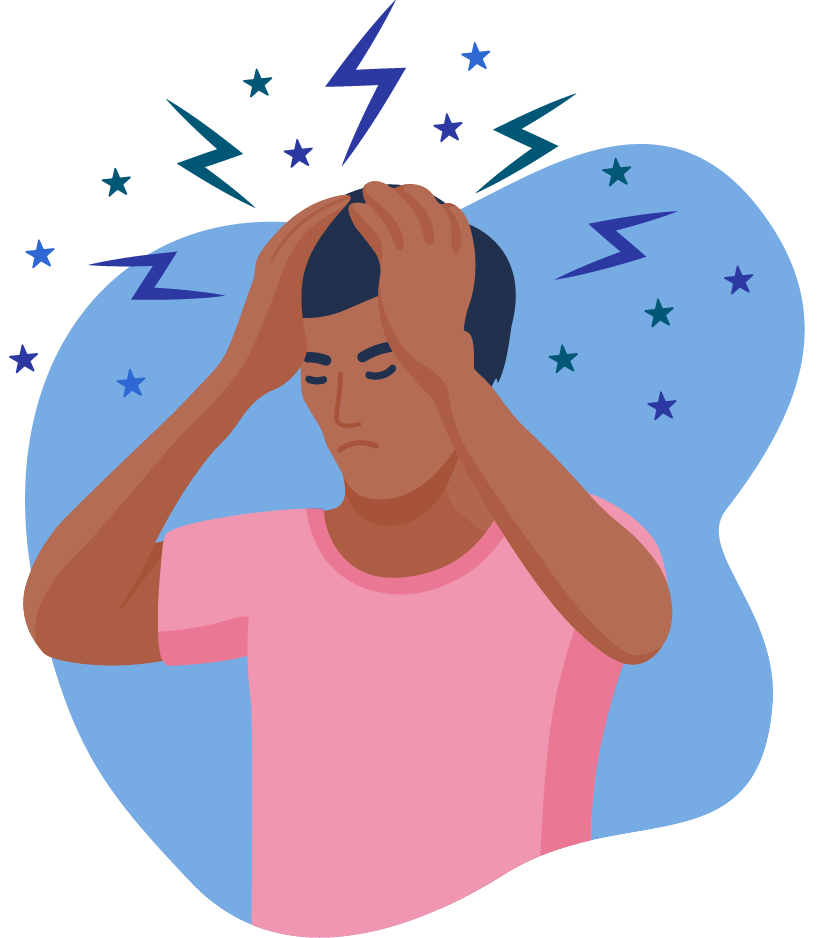
Quick Links
Resources
About MyMigraineTeam
Powered By






A silent migraine is a type of migraine that happens without a headache. While a severe headache is usually a sign of migraine, a silent migraine involves symptoms like visual disturbances, dizziness, and nausea but no headache.
People with migraine sometimes experience aura as a “warning sign” before headache pain starts. They may also experience aura symptoms during their headaches. During a silent migraine, people get aura without the head pain.
One MyMigraineTeam member wrote, “Something new happened today. I had all the symptoms of a migraine — nausea, light and sound sensitivity, and chills. But I didn’t have migraine pain.”
According to Cleveland Clinic, about 5 percent of people with migraine experience silent migraine. Although silent migraine is less common, it can still affect your quality of life. Aura symptoms can be scary and make daily tasks, like reading on a computer screen or driving, difficult or even impossible.
As one MyMigraineTeam member reported, “I can be at work, happy as anything. Then the next minute, I get a blind spot — my hand starts going numb. Then I have to run home right away.”
Silent migraine is also sometimes known as acephalgic migraine, amigrainous migraine, or “typical aura without headache.” If it affects the eyes, it can also be called ocular migraine.
Silent migraine can cause a range of symptoms, including:
A MyMigraineTeam member described their migraine symptoms as “red lights flashing all around my room. The red flashing continued for a few minutes. Sometimes, it looks more like moving grayish flying shadows.”
Another member shared, “My vision goes to nearly black with purple and green glowing lights that bubble back and forth like a ’70s-era lava lamp.”
These symptoms can be mistaken for a stroke, especially something called a transient ischemic attack (TIA) or “ministroke.” If you experience symptoms like sudden numbness or weakness that feels worse than your usual silent migraine, seek emergency medical care.
Researchers have linked silent migraine to changes in brain activity known as cortical spreading depression (CSD). CSD happens in the cerebral cortex, the part of the brain that controls senses and movement. There may also be a genetic component to CSD that makes some people more likely to experience silent migraine.
Certain personal and environmental factors can trigger a silent migraine. Common silent migraine triggers include:
Silent migraine can be difficult to treat. Many migraine medications target headaches, not aura symptoms. Since auras usually last less than an hour, typical migraine treatments and slow-acting drugs such as over-the-counter painkillers or oral triptans may not help in time.
As of 2024, there are no FDA-approved treatments specifically for silent migraine. However, therapies approved for migraine with aura, like calcitonin gene-related peptide (CGRP) inhibitors, may help prevent silent migraine attacks that include aura symptoms without head pain. Neuromodulation devices, which affect nerve activity, may also relieve nonpain symptoms seen in silent migraine. Experts are still researching potential treatments specifically for silent migraine.
Understanding your silent migraine symptoms and triggers can help you manage them. If pain relievers help you during a silent migraine, taking them earlier may help prevent symptoms from worsening.
While there aren’t specific treatments for silent migraine, there are some things you can do to help ease your symptoms during a silent migraine attack. Cleveland Clinic suggests:
If you experience migraine or silent migraine, it’s best to consult with a health care provider about possible treatments. They can help you create a treatment plan for your specific symptoms.
MyMigraineTeam is the social network for people with migraine and their loved ones. On MyMigraineTeam, more than 83,000 members come together to ask questions, give advice, and share their stories with others who understand life with migraine, including silent migraine.
Do you have silent migraine? What tips do you have for preventing or treating silent migraine? Share your experience in the comments below, or start a conversation by posting on your Activities page.

Are your headaches a symptom of migraine? Get a quick assessment.



Get updates directly to your inbox.
Does Anyone Experience Their Migraines Come And Go Throughout The Day And Sometimes They Last Up To 3-4 Days?
Ever Try To Explain To Your Doctor That You Have These Symptoms But No Pain? And They Look At You Like You Are Crazy?
What Causes A Tumor Called Pituitary?
Going Through Menopause And The Amount Of Silent Migraines Has Jumped From 1 Or 2/year To 5/month. How Long Will This Last?
 Amit M. Shelat, D.O.
is a fellow of the American Academy of Neurology and the American College of Physicians. Review provided by VeriMed Healthcare Network.
Learn more about him here.
Amit M. Shelat, D.O.
is a fellow of the American Academy of Neurology and the American College of Physicians. Review provided by VeriMed Healthcare Network.
Learn more about him here.
 Jessica Wolpert
earned a B.A. in English from the University of Virginia and an MA in Literature and Medicine from King's College.
Learn more about her here.
Jessica Wolpert
earned a B.A. in English from the University of Virginia and an MA in Literature and Medicine from King's College.
Learn more about her here.


Become a member to get even more:




A MyMigraineTeam Member
I have had for 8 years....not one neurologist could diagnose it in Arizona....I went to Utah to Dr. DIGREE.... wow... amazing doctor....they just returned this month after 4 month relief. I was… read more
We'd love to hear from you! Please share your name and email to post and read comments.
You'll also get the latest articles directly to your inbox.